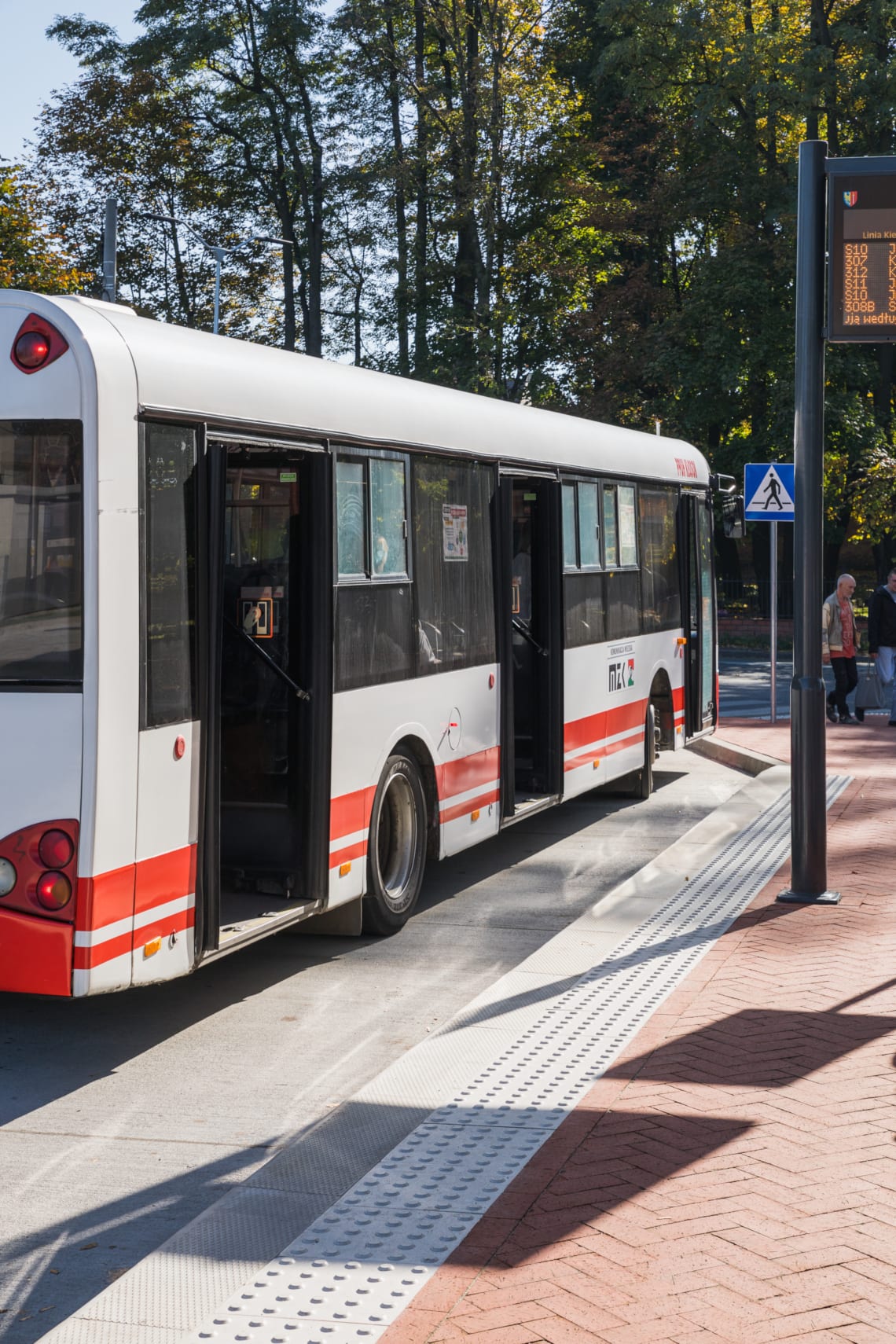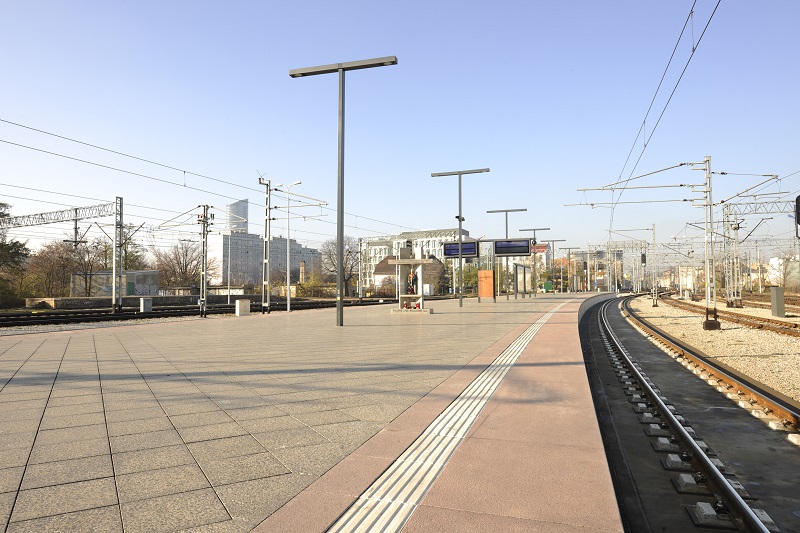
Tactile paths and warning markings are an extremely important element in the design of public spaces for the visually impaired and blind. These are innovative solutions that facilitate movement in the urban environment and around public facilities.
Guided touch paths are placed at the surfaces of communication routes, e.g. at pedestrian crossings or intersections. It can be found in various public places, such as bus or tram stops, platforms at the railway station and airports.
The tactile path for the blind and visually impaired increases the safety of movement of people with disabilities and improves the use of public institutions.
By setting paths, it is possible to create public space available to everyone. Why else is it important in the design of modern urban facilities?
What are tactile paths, i.e. horizontal markings for blind pedestrians?
Tactile paths are special horizontal markings in the form of dots or convex guide lines that can be felt under the feet, which can be installed in specific places, e.g. on paving slabs or inside public buildings.
These tactile surfaces are adapted to the needs of blind and visually impaired people who move with the help of a white cane. They enable safe movement of the disabled in public spaces, both inside buildings and on the streets. The protrusions in the surface are also not an obstacle for wheelchair users.
Guidance lines and paths play an important role in the design of public places accessible to everyone and enable the blind and visually impaired to use urban space.

How important are warning strips for the blind?
Warning strips for the blind are an extremely important element in public spaces, aimed at increasing the safety of people with visual impairment.
These specially developed convex elements, which are often within the field of attention for healthy people, are an important element of the tactile path system, enabling blind people to safely move on streets, sidewalks or city squares, wherever a path with markings leads.
The design of the markings is characterized by a contrasting color and a specific texture, which allows them to be felt with the feet. Signage is a potential signal of danger for the blind and visually impaired.
Thanks to the use of such protrusions on paving slabs in the direction of traffic, the disabled person knows that he or she is approaching an area that requires special care. Therefore, for people with disabilities, such protrusions are an indispensable element that increases their autonomy and comfort in everyday movement in public space.
Where are guidance paths for the blind used?
The installation of tactile paths and special markings for the blind and visually impaired takes place wherever a disabled person needs to be given a signal of potential danger.
So we can find them on curbs, at pedestrian crossings, at railway stations, at bus stops, in offices, libraries and museums.
These extremely useful ready-made architectural solutions exist wherever there is a need to inform a disabled person about the danger, so that they can safely and confidently move around in public space and be an active member of society, regardless of their disability.

Are horizontal signage for the blind really effective in increasing accessibility?
Horizontal markings for the blind are an effective tool in improving the accessibility of public spaces. These special markings, such as tactile paths or warning strips, are crucial for people with visual impairments, enabling them to move safely and independently in urban environments.
With contrasting colours and clear textures, the horizontal markings provide sensory information that blind people can sense with their feet or cane. Although guide strips are often equipped with small bumps the size of a pin, they are a sufficient signal for a disabled person about an impending change in the environment, so that they can be particularly careful when moving.
Thanks to this, they can orient themselves in space, identify dangerous areas or approaching obstacles. The effectiveness of these markings lies not only in their visibility, but also in their sensory sense.
Types of Guidance Lines for the Blind in Signage Design
Guidance lines for the blind offer the creation of public spaces accessible to everyone. There are several types of lines that perform different functions, aimed at facilitating the movement of the blind and visually impaired in urban environments. They should be included in the typhlographic plan of the designed space and mounted wherever necessary.
The types of guidance lines for the blind and visually impaired are:
Directing lines – are straight lines running along sidewalks or crossings, helping the blind to maintain the direction of traffic. They can take the form of contrasting plates and can also be felt by the feet thanks to a special texture.
Warning lines – these are pin-mounted lines that signal when approaching dangerous areas such as curbs, stairs or other obstacles. They can be made of concrete or plastic. Their contrasting color and special structure are a sign that a blind person should be careful.
Information lines – act as a guide through public space, leading to important points such as bus stops, entrances to buildings or public places.

How are blind strips and guide strips installed in sidewalks and at pedestrian crossings?
Belts for the blind are an important element of designing accessible spaces. The process of installing these strips on pavements and floors requires precise planning and the use of appropriate materials.
These belts are often made of materials with a higher texture or contrasting color so that they are easily felt by both feet and canes for blind people.
In practice, the installation of blind strips usually involves placing special tiles or elements with a different degree of roughness in relation to the surrounding surface. These lanes are placed in strategic locations such as pedestrian crossings, intersections, and bus stops to provide a clear guidance path.
DASAG designs and manufactures paths for the blind and visually impaired
One of the best materials from which markings for the blind and visually impaired can be made is definitely noble concrete, which offers a unique design, full safety and durability for years. Thanks to this, it is possible to design a functional public space in which people with various disabilities can find themselves.
The paths for the blind from the DASAG offer are a combination of unique design and safety. We make every effort to ensure that the signage we create is not only practical, but also fits perfectly into the architecture of the place where it is to be installed.
In addition, we are able to adapt to the requirements of individual and private customers – and on special order create a product that will perfectly fit into the city street or building.
We encourage you to familiarize yourself with our offer of markings and tactile paths for the blind and visually impaired.
